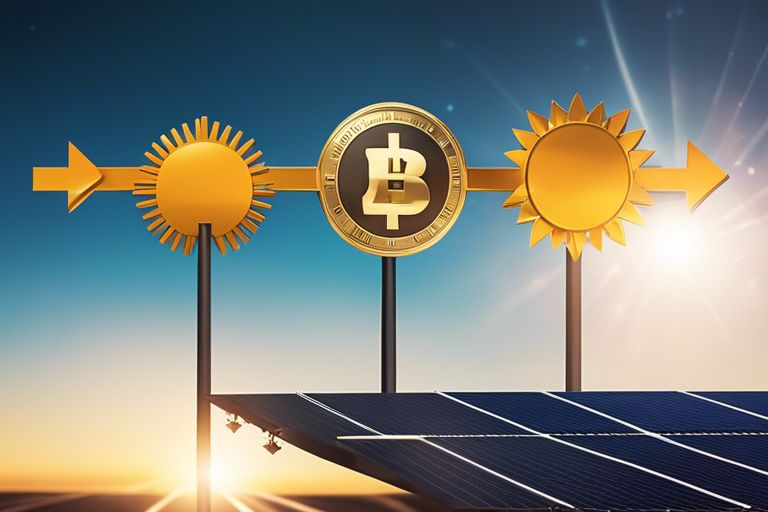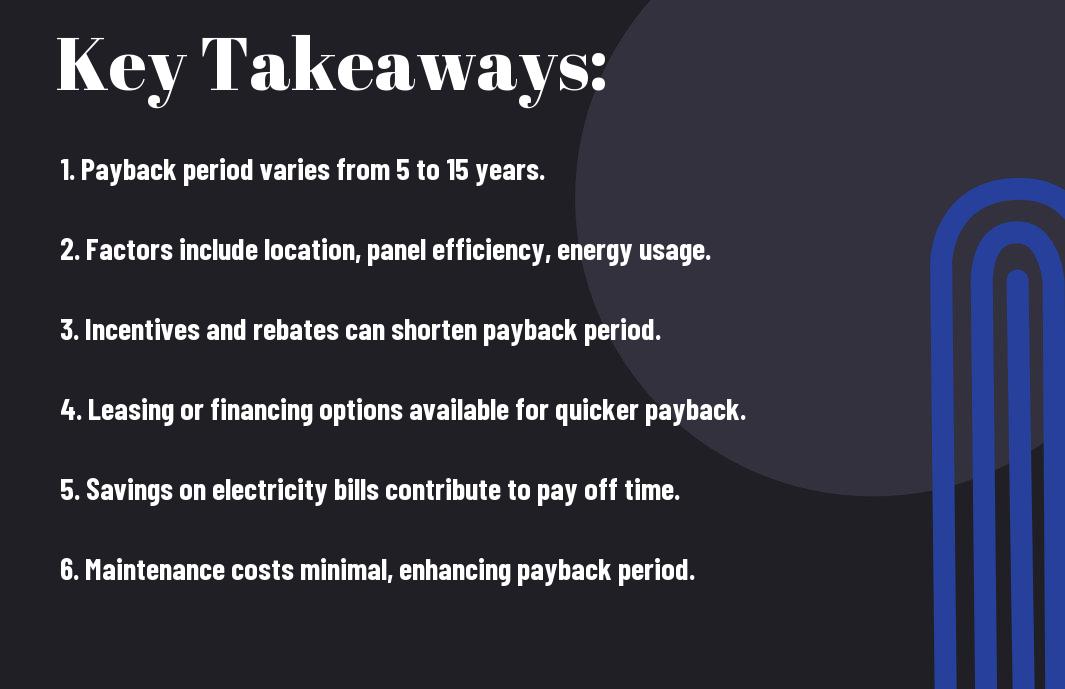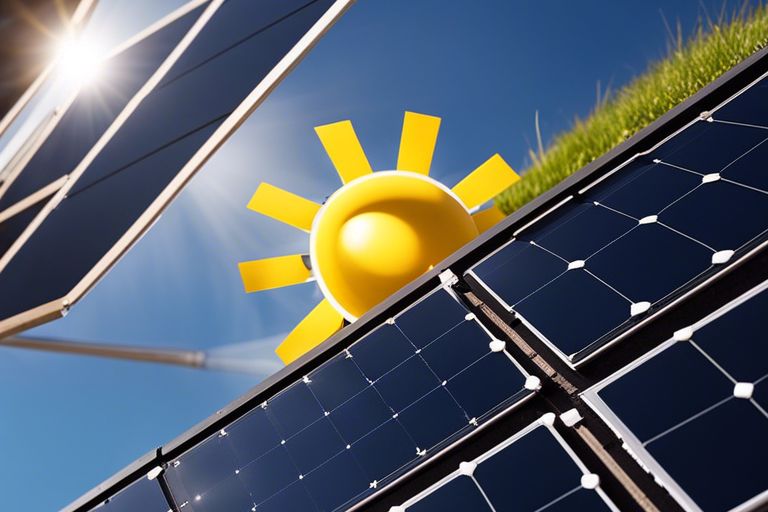Most homeowners wonder how many years it takes to pay off solar panels. Investing in solar energy not only benefits the environment but also your wallet in the long run. In this blog post, we will break down the factors that influence the payback period of solar panels, helping you make an informed decision about going solar. By the end, you will have a clearer understanding of how many years it might take for you to recoup your investment and start enjoying the savings.

Key Takeaways:
- Payback Period: The payback period for a solar panel system is typically between 5 to 10 years, depending on various factors such as energy usage, location, system size, and incentives.
- Return on Investment (ROI): Solar panels can provide a good ROI over their 25-30 year lifespan, with potential savings on utility bills and possible tax credits or rebates.
- Long-Term Savings: Once the solar panel system is paid off, homeowners can enjoy significant long-term savings on their electricity bills, as they are necessaryly generating free electricity from the sun.
Factors Affecting Payoff Period
While considering the payoff period for solar panels, there are several factors that can influence how long it takes for your investment to pay off. These factors include system size and quality, local electricity rates, and the amount of sunlight exposure your location receives.
System Size and Quality
On the topic of system size and quality, it’s necessary to understand that the size and quality of your solar panel system can significantly impact the payoff period. A larger, higher-quality system may have a higher initial cost but can also generate more electricity, leading to a shorter payoff period. Conversely, a smaller or lower-quality system may be more affordable upfront but might take longer to pay for itself in energy savings.
Local Electricity Rates
Factors such as local electricity rates play a crucial role in determining how long it will take to pay off your solar panels. If you live in an area with high electricity rates, your savings from generating your own electricity with solar panels will be more significant, potentially shortening the payoff period. On the other hand, in areas with lower electricity rates, it may take longer to see a return on your solar investment.
Local electricity rates can vary widely depending on where you live, so it’s necessary to research and compare rates in your area to understand how they will impact the payoff period for your solar panels.
Amount of Sunlight Exposure
Factors affecting the amount of sunlight exposure your location receives also play a crucial role in determining the payoff period for your solar panels. Regions with more sunlight exposure will generate more electricity from solar panels, leading to faster payoff periods. Conversely, areas with less sunlight may take longer for your solar panels to pay off.
Affecting the amount of sunlight exposure is the tilt and orientation of your solar panels, as well as potential shading from nearby structures or trees. Optimizing these factors can help maximize the amount of sunlight your panels receive and shorten the payoff period for your solar investment.
Calculating the Payoff Period
One How long until solar panels pay for themselves? method involves calculating the payoff period of your solar panels. This period refers to how long it takes for your initial investment in solar to be recouped through savings on your electricity bills. There are several ways to calculate this, including a simple formula, considering inflation and discount rates, and utilizing online tools.
Simple Payback Period Formula
Simple Payback Period is a straightforward calculation. You take the total cost of your solar panel system and divide it by the annual savings on your electricity bill. This will give you the number of years it will take to pay off your solar investment. For example, if your system costs $10,000 and you save $1,000 per year on electricity, your payback period would be 10 years.
Considering Inflation and Discount Rates
Rates of inflation and discount impact the value of money over time. By factoring these into your calculations, you get a more accurate picture of your solar investment’s payoff period. Inflation decreases the purchasing power of money, while the discount rate reflects how much you value future savings compared to immediate benefits.
Payoff period calculations become more robust when you consider these economic factors. If inflation rates are high, it may take longer for your solar investment to pay off. Similarly, a higher discount rate implies you value immediate savings more, which could shorten the payoff period.
Using Online Calculators and Tools
Period There are various online tools and calculators available to help you determine the payoff period of your solar panels. These tools can factor in your location, electricity rates, system size, and other variables to provide a more accurate estimate of when your solar investment will break even.
Understanding how to use these tools can be beneficial in making informed decisions about going solar. By inputting your specific data, you can get a clearer picture of the financial benefits and payback timeline for your solar panel system.
Average Payoff Periods for Different Systems
Residential Solar Systems
Periods to pay off residential solar systems can vary depending on factors like the size of your system, energy consumption patterns, and local incentives. On average, it takes around 5 to 8 years to pay off a residential solar system. Following the payback period, you can enjoy free electricity for the remaining lifespan of your solar panels, typically 25 years or more.
Commercial Solar Systems
Different from residential systems, commercial solar setups are often larger in scale and can take around 4 to 7 years to pay off. Factors that can influence this timeline include the energy needs of the business and the available incentives. Commercial solar systems not only help businesses save on electricity costs but also position them as environmentally conscious, which can be a valuable asset in today’s market.
Investing in a commercial solar system not only provides financial benefits but also demonstrates a commitment to sustainability, which can enhance your brand image and attract eco-conscious customers.
Industrial Solar Systems
For industrial solar systems, the payoff period can range from 3 to 6 years, depending on the size of the installation and energy usage. Industrial solar systems are typically larger and require a higher upfront investment, but the potential savings and environmental impact are substantial. By investing in an industrial solar system, you not only reduce your energy costs but also contribute to a more sustainable future.
Residential, commercial, and industrial solar systems offer significant long-term benefits, including reducing electricity bills, increasing energy independence, and reducing carbon footprint. Consider the average payoff periods for different systems when choosing the right solar solution for your needs.
Government Incentives and Tax Credits
Now, let’s probe the various government incentives and tax credits that can help reduce the cost of going solar and shorten the time it takes to pay off your solar system.
Federal Solar Investment Tax Credit (ITC)
Credits: One of the most significant incentives is the Federal Solar Investment Tax Credit (ITC). This credit allows you to deduct up to 26% of the cost of installing a solar energy system from your federal taxes. This means that if your solar system costs $20,000, you could potentially save $5,200 on your taxes. However, it’s crucial to note that this percentage is set to step down in the coming years.
State and Local Incentives
On top of the federal ITC, many states and local governments offer additional incentives to encourage homeowners to go solar. These incentives can vary widely depending on where you live but may include rebates, grants, performance-based incentives, or property tax exemptions.
With these additional incentives, the upfront cost of installing a solar system can be significantly lower, making it an even more financially attractive option for you.
Net Metering Laws
Credits: Net metering laws allow you to sell excess electricity generated by your solar panels back to the grid, effectively spinning your utility meter backward. This means that you can offset the cost of any electricity you need to buy from the grid with the excess energy your solar system produces. In some cases, you may even earn credits on your utility bill for the surplus energy you contribute.
A combination of these government incentives and tax credits can help you pay off your solar system faster and start enjoying the long-term savings and benefits of solar energy sooner rather than later.
Financing Options and Their Impact
Cash Purchase vs. Loan Financing
On your journey to pay off solar, you will come across the decision of whether to make a cash purchase or opt for loan financing. With a cash purchase, you will own the system outright, reaping all the financial benefits in the long run. However, not everyone has the resources for such a significant upfront investment. Loan financing allows you to spread the cost over a period of time, making solar more accessible. While you will have to pay interest on the loan, the savings from solar energy production can often offset this cost.
Leasing and Power Purchase Agreements
Options for leasing or entering into power purchase agreements (PPAs) can provide you with another way to go solar without the large initial investment. With leasing, you imperatively rent the solar panel system and pay a fixed monthly amount for its use. PPAs involve a third-party owning the system on your property and selling you the electricity it produces at a predetermined rate. While these options may not result in you owning the system, they can still lead to savings on your energy bills.
It is imperative to carefully consider the terms of leasing or PPAs, as they may involve long-term contracts that could limit your flexibility in the future. However, for those who are unable to make a cash purchase or qualify for a solar loan, these options can still allow you to benefit from solar energy.
Effect of Interest Rates on Payoff Period
Power.
Financing.

Maintenance and Repair Costs
For Solar Payback Period: How Soon Will It Pay Off?, it’s important to consider maintenance and repair costs when assessing the overall payoff of your solar panels. Ensuring that your system is well maintained and addressing any repairs promptly can help you maximize the financial benefits of your solar investment.
Average Annual Maintenance Costs
Repair and replacement costs for solar panels are generally low due to their durability. On average, you can expect to spend about $100 to $150 per year on maintenance expenses. These costs may include cleaning the panels, inspecting the system for any issues, and ensuring that all components are functioning properly.
Repair and Replacement Costs
Repair and replacement costs for solar panels are typically rare, but if any components do malfunction or need replacing, these expenses can vary. In some cases, repairs may be covered under your warranty, reducing the financial burden on you. However, it’s necessary to budget for unexpected repair or replacement costs that may arise over the years.
Maintenance and repairs seldom impact the overall payback period significantly. With proper care and occasional repairs, your solar panels can continue to generate clean energy efficiently for many years, maintaining their financial benefits and environmental impact.
Impact on Payoff Period
Costs associated with maintenance and repairs generally have a minimal impact on the payoff period of your solar panels. By budgeting for these expenses and keeping your system well maintained, you can ensure that your solar investment remains profitable and sustainable in the long run. This proactive approach can help you maximize the financial benefits of your solar panels and enjoy clean, renewable energy for years to come.

Summing up
Now that you have a better understanding of how to calculate your solar payback period, you can make a more informed decision about whether investing in solar panels is a financially viable option for you. Keep in mind, factors such as location, energy usage, local incentives, and upfront costs will all play a role in determining how many years it will take for you to pay off your solar investment. To learn more about calculating your solar payback period, visit How to Calculate Your Solar Payback Period: Find Out ….
Q: How many years does it take to pay off solar?
A: The payback period for solar panels typically ranges from 5 to 15 years, depending on various factors such as the cost of the system, available incentives, electricity rates, and the amount of sunlight your location receives.
Q: What factors can affect the time it takes to pay off solar panels?
A: Factors that can impact the payback period of solar panels include the cost of the system, energy usage habits, available incentives such as tax credits or rebates, electricity rates, financing options, and the amount of sunlight your location receives.
Q: How can I shorten the payback period for solar panels?
A: You can shorten the payback period for solar panels by taking advantage of available incentives, such as tax credits and rebates, choosing a financing option with low interest rates, using energy-efficient appliances to reduce overall energy consumption, and ensuring the solar panels are installed in a location that receives ample sunlight.
